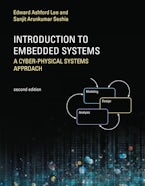

The most visible use of computers and software is processing information for human consumption. The vast majority of computers in use, however, are much less visible. They run the engine, brakes, seatbelts, airbag, and audio system in your car. They digitally encode your voice and construct a radio signal to send it from your cell phone to a base station. They command robots on a factory floor, power generation in a power plant, processes in a chemical plant, and traffic lights in a city. These less visible computers are called embedded systems, and the software they run is called embedded software. The principal challenges in designing and analyzing embedded systems stem from their interaction with physical processes. This book takes a cyber-physical approach to embedded systems, introducing the engineering concepts underlying embedded systems as a technology and as a subject of study. The focus is on modeling, design, and analysis of cyber-physical systems, which integrate computation, networking, and physical processes.
The second edition offers two new chapters, several new exercises, and other improvements. The book can be used as a textbook at the advanced undergraduate or introductory graduate level and as a professional reference for practicing engineers and computer scientists. Readers should have some familiarity with machine structures, computer programming, basic discrete mathematics and algorithms, and signals and systems.
Edward Ashford Lee is Distinguished Professor (Emeritus) in Electrical Engineering and Computer Sciences at the University of California, Berkeley, where he runs iCyPhy, a research center focused on industrial cyber-physical systems. He is the author of Plato and the Nerd (MIT Press) and other books.
Sanjit A. Seshia is a Professor in the Department of Electrical Engineering and Computer Sciences at the University of California, Berkeley.
Books titled Introduction to Embedded Systems traditionally focus on computer hardware and software. By taking A Cyber-Physical Systems Approach, Lee and Seshia give students the integrated perspective they need to understand and design the computing systems that make our world function. No other book provides such a comprehensive introduction to embedded systems for real-time applications.
Bruce H. Krogh, Professor of Electrical and Computer Engineering, Carnegie Mellon University
Introduction to Embedded Systems by Lee and Seshia is an introductory yet rigorous textbook for the future Internet of Things engineer. It provides a unified systems view of computing and the physical world that will be the foundation of the 21st-century Internet of Things revolution.
George J. Pappas, Joseph Moore Professor, University of Pennsylvania
Designers of embedded systems are only too often overwhelmed by the many skills and disciplines that have to be mastered: from writing device drivers, to worst case execution time analysis, to formal verification and modeling of continuous time systems. This book by Lee and Seshia is an excellent guide to bringing order into these complexities of design by discerning the fundamental from the detail, the essential property from the accidental aspect. It presents all the indispensable knowledge areas for an embedded systems designer and leaves out what can be delegated to other specialized disciplines.
Axel Jantsch, Professor of Systems on Chips, Institute of Computer Technology, TU Wien, Vienna; author of Modeling Embedded Systems and SoC's
The outstanding property of this textbook is the combination of mathematical rigor and comprehensiveness. It is presented with numerous examples and with such quality that understanding the material is easy. Introduction to Embedded Systems is a must-read for those wanting to master the complexity of what is today the key enabling technology in most every complex system surrounding us: embedded and cyber-physical systems.
Werner Damm, Director, Interdisciplinary Research Center on Cooperative Critical Systems, Carl von Ossietzky University of Oldenburg